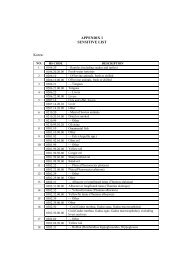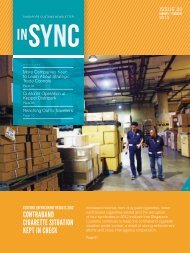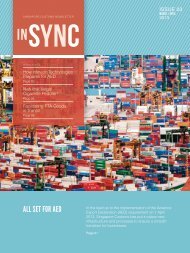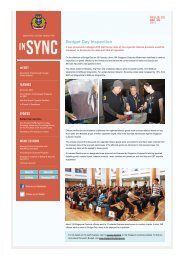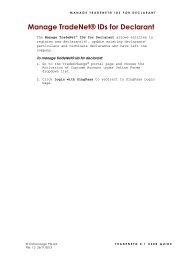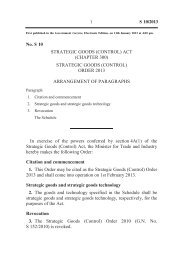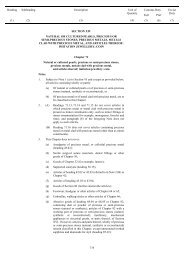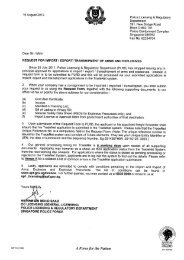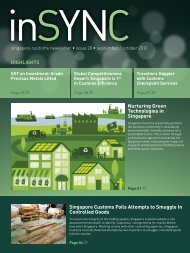Types of Permit Applications - Singapore Customs
Types of Permit Applications - Singapore Customs
Types of Permit Applications - Singapore Customs
Create successful ePaper yourself
Turn your PDF publications into a flip-book with our unique Google optimized e-Paper software.
Guide to <strong>Customs</strong>’ Procedures<br />
Module 5: TradeNet® <strong>Permit</strong> <strong>Applications</strong><br />
<strong>Types</strong> <strong>of</strong> <strong>Permit</strong> <strong>Applications</strong><br />
IMPORTS / MESSAGE TYPE “IN-NON-PAYMENT”<br />
INP (APS) .............................................................................................................................................. 2<br />
INP (BKT) .............................................................................................................................................. 3<br />
INP (DES).............................................................................................................................................. 4<br />
INP (GTR).............................................................................................................................................. 5<br />
INP (REX).............................................................................................................................................. 7<br />
INP (SFZ)............................................................................................................................................... 8<br />
INP (SHO) ............................................................................................................................................. 9<br />
INP (TCE, TCI, TCO, TCR, TCS) .................................................................................................... 10<br />
IMPORTS / MESSAGE TYPE “IN-PAYMENT”<br />
IPT (BKT)............................................................................................................................................. 11<br />
IPT (DNG)............................................................................................................................................ 12<br />
IPT (DUT) ............................................................................................................................................ 13<br />
IPT (GST) ............................................................................................................................................ 14<br />
EXPORTS / MESSAGE TYPE “OUT”<br />
OUT (APS) .......................................................................................................................................... 16<br />
OUT (BKT)........................................................................................................................................... 18<br />
OUT (DRT) .......................................................................................................................................... 19<br />
OUT (TCE, TCI, TCO, TCR, TCS) .................................................................................................. 20<br />
TRANSHIPMENTS AND REMOVALS / MESSAGE TYPE "TRANSHIPMENT/MOVEMENT"<br />
TNP (BRE)........................................................................................................................................... 21<br />
TNP (REM) .......................................................................................................................................... 22<br />
TNP (TTF) ........................................................................................................................................... 23<br />
TNP (TTI)............................................................................................................................................. 24<br />
TNP (IGM) ........................................................................................................................................... 25<br />
Last Updated: 09 April 2012 1
Guide to <strong>Customs</strong>’ Procedures<br />
Module 5: TradeNet® <strong>Permit</strong> <strong>Applications</strong><br />
INP (APS)<br />
Declaration Type “Approved Premises/Schemes” (APS)<br />
<br />
Bonding <strong>of</strong> Goods into a Licensed Warehouse<br />
A licensed warehouse is used for storage <strong>of</strong> dutiable goods specified in the licence. Nondutiable<br />
goods are not to be declared in the same inward declaration. For bonding <strong>of</strong> dutiable<br />
goods in a licensed warehouse, lot numbers and product codes (e.g. Motor Vehicle Product<br />
Codes) must be declared. The declaration must be submitted by the licensee or his authorised<br />
agent.<br />
<br />
Movement <strong>of</strong> LCL containers with Class II/Dangerous Goods into a Class II Yard<br />
Warehouse<br />
This declaration type covers the movement <strong>of</strong> a LCL container containing goods classified by<br />
PSA as Class II or dangerous cargo into an approved Class II Yard warehouse pending<br />
unstuffing. The DG (Dangerous Goods) Indicator must be indicated as “Y” for such declaration<br />
type.<br />
The House Bill <strong>of</strong> Lading number has to be declared under HBL field for each line item. The lot<br />
no. has to be declared for each line item. A separate declaration is required for each LCL<br />
container.<br />
<br />
Bonding <strong>of</strong> Goods into a Bonded Warehouse or ZG Warehouse<br />
A bonded warehouse or ZG warehouse is used for storage <strong>of</strong> non-dutiable goods pending reexport.<br />
Dutiable goods must not be declared in the same declaration. The declaration must be<br />
submitted by the licensee or his authorised agent.<br />
(Note: A list <strong>of</strong> service licensed and ZG warehouses for storage <strong>of</strong> imported dutiable<br />
liquor/tobacco and goods subject to GST is available on <strong>Singapore</strong> <strong>Customs</strong>’ homepage at<br />
http://www.customs.gov.sg)<br />
<br />
Bonding <strong>of</strong> petroleum products or chemicals from an approved berth to a licensed<br />
warehouse or ZG warehouse<br />
The valid license numbers <strong>of</strong> the licensed warehouse or ZG warehouse must be declared in the<br />
Place <strong>of</strong> Receipt field.<br />
<br />
Import by traders registered under the Major Exporter Scheme (MES)<br />
To submit a declaration under MES, the importer must be registered with IRAS as a major<br />
exporter. The declaring agent must also be registered with IRAS as an authorised agent <strong>of</strong> the<br />
ME trader.<br />
The Place <strong>of</strong> Receipt field must be filled with “ME”.<br />
Last Updated: 09 April 2012 2
Guide to <strong>Customs</strong>’ Procedures<br />
Module 5: TradeNet® <strong>Permit</strong> <strong>Applications</strong><br />
INP (BKT)<br />
Declaration Type “Blanket” (BKT)<br />
Such declarations are used to cover several imports within the month. Only companies that are preapproved<br />
by <strong>Customs</strong> are allowed to declare such declarations.<br />
Last Updated: 09 April 2012 3
Guide to <strong>Customs</strong>’ Procedures<br />
Module 5: TradeNet® <strong>Permit</strong> <strong>Applications</strong><br />
INP (DES)<br />
Declaration Type “Destruction” (DES)<br />
<br />
Removal <strong>of</strong> Goods from FTZ for Destruction<br />
Importers who are bringing goods from the FTZ into customs territory for destruction are<br />
required to declare "DUMP" in the “Place <strong>of</strong> Receipt” field.<br />
<strong>Customs</strong> supervision/escort will not be required for destruction <strong>of</strong> non-dutiable goods with a<br />
total declared value <strong>of</strong> the consignment not exceeding $10,000.00 and that the importer is a<br />
taxable person registered with IRAS*.<br />
For destruction <strong>of</strong> controlled goods, prior approval from the Controlling Agency (CA) has to be<br />
obtained. Therefore, for destruction <strong>of</strong> such goods, trader should submit the declaration to<br />
<strong>Customs</strong> only after they have obtained approval from the relevant CA's approval for<br />
destruction*.<br />
The importer has to make arrangements with National Environment Agency for the date, time<br />
and venue <strong>of</strong> destruction. A copy <strong>of</strong> the disposal certificate has to be returned to <strong>Permit</strong>s<br />
Compliance Unit <strong>of</strong> <strong>Customs</strong> within 4 working days <strong>of</strong> the date <strong>of</strong> clearance <strong>of</strong> goods for<br />
destruction*.<br />
The destruction <strong>of</strong> dutiable goods is to be escorted and supervised by <strong>Customs</strong> unless this<br />
requirement is waived.<br />
(Note: * Please refer to <strong>Customs</strong> Cir. No.45/2000 dated 16 Oct 2000).<br />
Last Updated: 09 April 2012 4
Guide to <strong>Customs</strong>’ Procedures<br />
Module 5: TradeNet® <strong>Permit</strong> <strong>Applications</strong><br />
INP (GTR)<br />
Declaration Type “GST Relief and Duty Exemption (GTR)”<br />
GST relief is granted to a person or organisation listed in the Goods and Services Tax (Imports Relief)<br />
Order or the International Arrangements Relief Notification. Duty exemption is granted under the<br />
<strong>Customs</strong> (Duties) (Exemption) Order.<br />
This declaration type is to be submitted if the application is for both GST relief and duty exemption on<br />
dutiable goods. The approved permit is a GST Relief and Duty Exemption Certificate.<br />
This declaration type also covers GST relief to entitled person/ organization for non-dutiable goods<br />
under the legislation.<br />
<br />
Exemption on diplomatic goods<br />
Diplomats and consular members are eligible for duty exemption and GST relief on all goods.<br />
The items declared may be dutiable, non-dutiable or a combination <strong>of</strong> both dutiable and nondutiable<br />
goods.<br />
The place <strong>of</strong> receipt code is “EM”.<br />
<br />
Exemption on Motor Vehicles<br />
Dutiable motor vehicles may be granted duty exemption subject to payment <strong>of</strong> GST. A foreign<br />
expert assigned by their Government to <strong>Singapore</strong> may be eligible for exemption on a motor<br />
vehicle for his personal use. This Declaration Type covers cases where the expert is also<br />
eligible for GST relief. The valid place <strong>of</strong> receipt code is “EXEMPT”.<br />
Please note that if the foreign expert is only eligible for duty-exemption and not entitled to GST<br />
relief, GST will be payable and the correct message and declaration type will be IN-PAYMENT<br />
(GST).<br />
<br />
Exemption on Ethyl Alcohol<br />
Duty exemption is granted on ethyl alcohol for medical or research and development use. If the<br />
goods are directly imported by a government department, GST relief and duty exemption are<br />
granted for direct import made by government bodies. The place <strong>of</strong> receipt code is “ETHYL”.<br />
Please note that if the ethyl alcohol is for research purposes and not directly imported by<br />
government department, then GST is payable and the correct message and declaration type<br />
will be IN-PAYMENT (GST).<br />
<br />
GST Relief on used personal and household effects<br />
GST relief on used personal and household effects is granted to persons transferring<br />
residence to <strong>Singapore</strong>. The items must be used and owned by the importer for not less than<br />
3 months.<br />
A declaring agent or freight forwarder can, on behalf <strong>of</strong> the owner, submit an application for<br />
GST relief on used household articles and personal effects through<br />
http://www.tradexchange.gov.sg, under online forms.<br />
Upon receiving the letter <strong>of</strong> approval <strong>of</strong> the application, a PE Reference Number will be issued<br />
to the applicant. This number is to be declared in the CA License Number field in his<br />
TradeNet® application for a <strong>Customs</strong> GST relief Certificate.<br />
Last Updated: 09 April 2012 5
Guide to <strong>Customs</strong>’ Procedures<br />
Module 5: TradeNet® <strong>Permit</strong> <strong>Applications</strong><br />
<br />
GST Relief on empty container/pallet/packing<br />
GST relief is granted on re-usable empty containers, cylinders, pallets and all similar packing<br />
which are to be used for packing other goods for export.<br />
The place <strong>of</strong> receipt is “RECYCL”.<br />
The claimant and the company must be registered with the <strong>Customs</strong>. A <strong>Customs</strong> GST relief<br />
certificate is required except for empty containers and ISO tanks.<br />
Note: <strong>Customs</strong> has waived the requirement to produce a GST Relief Certificate for the<br />
temporary import <strong>of</strong> empty containers and ISO tanks, which are used in the conveyance <strong>of</strong><br />
goods, for subsequent export to other countries.<br />
For containers that are imported into <strong>Customs</strong> territory as a purchase from an overseas<br />
supplier, a <strong>Customs</strong> GST payment permit has to be taken out. Ref: <strong>Customs</strong> Cir No 30/2002<br />
with effect from 8 Aug 2002.<br />
<br />
GST Relief on goods directly imported by a Government Department<br />
For non-dutiable goods directly imported by a government department, GST relief is granted.<br />
The claimant and entity must be registered with <strong>Customs</strong>.<br />
The place <strong>of</strong> receipt code is “GOVT”.<br />
<br />
Exemption on military stores to foreign forces<br />
Foreign forces are eligible for duty exemption and GST relief on military stores directly<br />
imported. Goods can be dutiable or non-dutiable or a combination <strong>of</strong> the two. The place <strong>of</strong><br />
receipt must be a valid exemption code.<br />
Last Updated: 09 April 2012 6
Guide to <strong>Customs</strong>’ Procedures<br />
Module 5: TradeNet® <strong>Permit</strong> <strong>Applications</strong><br />
INP (REX)<br />
Declaration Type “Re-export” (REX)<br />
<br />
Import for re-export <strong>of</strong> dutiable or non-dutiable goods<br />
Traders are only required to submit 1 declaration for the import and re-export <strong>of</strong> goods<br />
(excluding goods subject to export control by any CA) via approved entry and exit points,<br />
whether or not involving inter-gateway movements.<br />
Both the inward and outward transport details must be declared in the same declaration for the<br />
consignment. The Place <strong>of</strong> Storage field should not be filled for such cases.<br />
For liquors or tobacco imported for re-export, trader is required to take out declaration type =<br />
REX. The outward transport details such as vessel name/flight number, departure date etc<br />
have to be declared.<br />
For goods other than liquors or tobacco imported for re-export and for which outward transport<br />
details are not available, traders should continue to submit separate declarations for the import<br />
and export <strong>of</strong> the goods.<br />
Last Updated: 09 April 2012 7
Guide to <strong>Customs</strong>’ Procedures<br />
Module 5: TradeNet® <strong>Permit</strong> <strong>Applications</strong><br />
INP (SFZ)<br />
Declaration Type “Storage in FTZ” (SFZ)<br />
<br />
Storage <strong>of</strong> Goods in the same FTZ<br />
Except for dutiable liquor and tobacco, goods imported from a foreign territory may be imported<br />
into <strong>Singapore</strong> and temporarily stored in the FTZ, pending release for local consumption or reexport<br />
to foreign countries.<br />
For example: If a consignment <strong>of</strong> garments is imported from US by sea (e.g. Keppel FTZ)<br />
before it is being re-exported by sea via the same FTZ, then the location information should be<br />
filled as follows:<br />
(i)<br />
Place <strong>of</strong> Release = KZ<br />
(ii)<br />
Place <strong>of</strong> Receipt = KZ<br />
<br />
Storage <strong>of</strong> Goods in the second FTZ (with inter-gateway movement)<br />
This Declaration Type also covers the import <strong>of</strong> goods for storage in the second FTZ, pending<br />
local release or re-export to foreign countries.<br />
For example: If a consignment <strong>of</strong> garments is imported from Penang by road (e.g. Tuas<br />
Checkpoint) and brought into Keppel Distripark for storage before it is being re-exported by sea<br />
via the Keppel FTZ, then the location information should be filled as follows:<br />
(iii) Place <strong>of</strong> Release = THQ<br />
(iv) Place <strong>of</strong> Receipt = KZ<br />
Last Updated: 09 April 2012 8
Guide to <strong>Customs</strong>’ Procedures<br />
Module 5: TradeNet® <strong>Permit</strong> <strong>Applications</strong><br />
INP (SHO)<br />
Declaration Type “Shut Out” (SHO)<br />
The following scenarios are covered under this Declaration Type:<br />
<br />
Returning <strong>of</strong> Shut-out Cargoes from a Free Trade Zone to Licensed/ZGS Warehouse<br />
The Outward <strong>Permit</strong> number must be declared in the Previous <strong>Permit</strong> Number field so as to skip<br />
the inward transport information. Lot number and the relevant product codes must also be<br />
declared for re-bonding <strong>of</strong> dutiable goods into a licensed warehouse.<br />
<br />
Returning <strong>of</strong> Local Shut-out Non-Dutiable Cargoes from a Free Trade Zone to Local<br />
Warehouse<br />
This includes non-dutiable cargoes which are removed earlier from <strong>Singapore</strong> into FTZ for<br />
export but shut-out by vessel and to be returned to local warehouse.<br />
The following supporting documents will be produced to the Checkpoint <strong>of</strong>ficers for verification:<br />
a) a letter from the exporter or his agent explaining the reasons for taking delivery <strong>of</strong> the<br />
shut-out goods;<br />
b) delivery note, invoice and other supporting documents.<br />
(Note: Such declarations cannot be used for the clearance <strong>of</strong> local goods moved into the FTZ<br />
for storage. For local cargoes moved into the FTZ for storage, the cargoes will be subject to the<br />
payment <strong>of</strong> GST on entering customs territory).<br />
Last Updated: 09 April 2012 9
Guide to <strong>Customs</strong>’ Procedures<br />
Module 5: TradeNet® <strong>Permit</strong> <strong>Applications</strong><br />
INP (TCE, TCI, TCO, TCR, TCS)<br />
Declaration Type “Temporary Consignment” (TCE, TCS, TCR, TCO)<br />
<br />
Temporary Import <strong>of</strong> Goods for Exhibition, repairs, etc.<br />
The Temporary Import Scheme (TIS) is administered by <strong>Customs</strong> to facilitate the temporary<br />
import <strong>of</strong> goods (excluding dutiable liquors and tobacco) for:<br />
(i) exhibition (declaration type TCE)<br />
(ii) exhibition cum sales or auctions (declaration type TCS)<br />
(iii) repair or modifications (declaration type TCR)<br />
(iv) other approved purposes such as inspection, stage performance or racing (declaration<br />
type TCO).<br />
The Start Date <strong>of</strong> Exhibition/End Date <strong>of</strong> Exhibition/Temporary Import Period must be declared<br />
for these declarations.<br />
In general, goods imported under TIS are to be re-exported within 6 months from date <strong>of</strong><br />
importation. Non-dutiable goods, dutiable goods or a combination <strong>of</strong> these 2 may be imported<br />
temporarily for a maximum period <strong>of</strong> 6 months for the above purposes. However, for<br />
declaration types TCE & TCS, goods must be re-exported within 21 days from the end-date <strong>of</strong><br />
exhibition.<br />
A bank guarantee is required to be furnished to cover the potential duty/GST amount on these<br />
temporarily imported goods.<br />
Declaration Type “Temporary Export/Re-imported Goods” (TCI)<br />
These declarations cover the re-import/return <strong>of</strong> the following types <strong>of</strong> goods:<br />
<br />
<br />
Goods previously exported temporarily for the purpose <strong>of</strong> exhibition, repairs, tests, projects or<br />
on rental<br />
Goods previously exported but are rejected by overseas buyers<br />
To submit inward declaration with declaration type TCI for re-importation <strong>of</strong> the goods, the relevant<br />
Outward <strong>Permit</strong> number must be declared in the Previous <strong>Permit</strong> Number field.<br />
Supporting documents to be produced for verification include the previously approved Outward<br />
<strong>Permit</strong>, outward B/L, exporter’s invoice, manufacturer’s invoice for locally manufactured goods or<br />
previous Import <strong>Permit</strong> if goods were originally imported into and supplied in <strong>Singapore</strong>. For imported<br />
goods, if GST had previously been paid, it must not have been refunded. For dutiable goods <strong>of</strong><br />
foreign origin, the duty must be paid on re-importation.<br />
Last Updated: 09 April 2012 10
Guide to <strong>Customs</strong>’ Procedures<br />
Module 5: TradeNet® <strong>Permit</strong> <strong>Applications</strong><br />
IPT (BKT)<br />
Declaration type “Blanket” (BKT)<br />
This declaration type is applicable for both dutiable and non-dutiable goods provided they are not<br />
mixed and for special arrangement only. For example:-<br />
(i) multiple releases <strong>of</strong> locally manufactured goods (eg beer, stout) from excise<br />
warehouse;<br />
(ii) payment <strong>of</strong> GST for imports <strong>of</strong> water and other imports previously covered<br />
under In-Non-Payment (BKT) for approved companies.<br />
Last Updated: 09 April 2012 11
Guide to <strong>Customs</strong>’ Procedures<br />
Module 5: TradeNet® <strong>Permit</strong> <strong>Applications</strong><br />
IPT (DNG)<br />
Declaration type “Duty & GST “ (DNG)<br />
This declaration type is to cover the payment <strong>of</strong> duty and GST. The declaration allows a mixture <strong>of</strong><br />
dutiable and non-dutiable goods to be declared with at least one dutiable item declared. For<br />
example:-<br />
(i) direct import <strong>of</strong> both dutiable and non-dutiable goods;<br />
(ii) release <strong>of</strong> dutiable goods stored in licensed warehouse;<br />
(iii) payment <strong>of</strong> duty and GST on dutiable goods previously imported under the temporary import<br />
scheme;<br />
(iv) short payment <strong>of</strong> duty and GST. (Place <strong>of</strong> receipt = SPNOSTK or SPSTK)<br />
Last Updated: 09 April 2012 12
Guide to <strong>Customs</strong>’ Procedures<br />
Module 5: TradeNet® <strong>Permit</strong> <strong>Applications</strong><br />
IPT (DUT)<br />
Declaration type “Duty” (DUT)<br />
This declaration type is to cover payment <strong>of</strong> duty but GST is suspended under import relief. Hence,<br />
the items declared must be for dutiable goods only. For example:-<br />
i) transfer <strong>of</strong> locally registered duty-exempted motor vehicle from entitled person to a non-entitled<br />
person. Place <strong>of</strong> release = EXEMPT and Place <strong>of</strong> receipt = O;<br />
ii) payment <strong>of</strong> duty on locally manufactured dutiable goods without supply;<br />
iii) dutiable goods with duty short paid only. (Place <strong>of</strong> receipt = SPNOSTK or SPSTK)<br />
Last Updated: 09 April 2012 13
Guide to <strong>Customs</strong>’ Procedures<br />
Module 5: TradeNet® <strong>Permit</strong> <strong>Applications</strong><br />
IPT (GST)<br />
Declaration type “GST (Including duty exemption) “(GST)<br />
This declaration type is to cover payment <strong>of</strong> GST only. The items declared are for non-dutiable goods<br />
or dutiable goods with duty being exempted. For example:-<br />
i) payment <strong>of</strong> GST on non-dutiable goods;<br />
ii) payment <strong>of</strong> GST for dutiable goods for which duty is exempted. For example, ethyl alcohol for<br />
research purposes, ethyl alcohol under industrial exemption, racing car, etc. Place <strong>of</strong> Receipt<br />
=ETHYL, IEFXXX, VEHRAC, etc.<br />
iii) dutiable goods with GST short paid only. (Place <strong>of</strong> receipt = SPNOSTK or SPSTK)<br />
Duty exemption is granted to a person or organization listed in the <strong>Customs</strong> (Duties) (Exemption)<br />
Order. For cases where the goods are subject to duty exemption without GST relief, GST will still be<br />
payable. The approved permit is a Duty Exemption/GST Payment <strong>Permit</strong>. Such applications are to be<br />
submitted under the following Message and Declaration Type:<br />
Message Type = IN-PAYMENT<br />
Declaration Type = GST<br />
For these applications, the Claimant Information must be declared accordingly.<br />
<br />
Exemption on Motor Vehicles<br />
Dutiable motor vehicles may be granted duty exemption subject to payment <strong>of</strong> GST. The<br />
following categories <strong>of</strong> vehicles are granted duty exemption according to the usage <strong>of</strong> the<br />
vehicle or on account <strong>of</strong> the eligibility <strong>of</strong> the claimant:<br />
1) A foreign expert assigned by the Government to <strong>Singapore</strong> may be eligible for exemption<br />
on a motor vehicle for his personal use. The valid place <strong>of</strong> receipt code is “EXEMPT”.<br />
2) A disabled person may be eligible to duty exemption on a vehicle modified to suit his<br />
disability. Exemption is granted if he has obtained waiver <strong>of</strong> COE and ARF from the LTA.<br />
The valid place <strong>of</strong> receipt code is “EXEMPT’.<br />
3) Exemption on golf cars, vintage cars, vehicles and toy vehicles.<br />
Duty Exemption is granted on:<br />
i) Vintage cars<br />
Duty exemption may be granted on vintage cars <strong>of</strong> pre-1940 models. Imported<br />
vintage cars shall not be resold in <strong>Singapore</strong> or disposed <strong>of</strong> in any manner<br />
without approval from <strong>Customs</strong>. Exemption is granted on condition that waiver <strong>of</strong><br />
ARF is granted by LTA unless they are not registered for use on public roads.<br />
The place <strong>of</strong> receipt code is “VEHVIN”.<br />
ii) Racing vehicles<br />
Duty exemption may be granted on racing vehicles including go-karts imported<br />
for racing purposes. The vehicles must be certified by LTA as racing cars or<br />
bikes and not to be registered for use on public roads. The place <strong>of</strong> receipt code<br />
is “VEHRAC”.<br />
Last Updated: 09 April 2012 14
Guide to <strong>Customs</strong>’ Procedures<br />
Module 5: TradeNet® <strong>Permit</strong> <strong>Applications</strong><br />
Note: For go-karts <strong>of</strong> petrol engines, not exceeding 1,000cc, the excise duty rate has<br />
been revised from 20% to Nil wef from 2 May 2008. As for other dutiable go-karts with<br />
petrol engines exceeding 1,000cc or <strong>of</strong> engines not running on petrol, traders can<br />
continue to apply for duty exemption for the imports. Please refer to <strong>Customs</strong> Circular<br />
10/2008 dated 28 April 2008 for more information.<br />
<br />
Exemption on Ethyl Alcohol<br />
Duty exemption is granted on ethyl alcohol for medical or research and development use. GST<br />
is payable upon approval <strong>of</strong> the permit. The place <strong>of</strong> receipt code is “ETHYL”.<br />
<br />
Industrial Exemption<br />
Duty exemption is granted on dutiable raw material for industrial use. GST is payable.<br />
Last Updated: 09 April 2012 15
Guide to <strong>Customs</strong>’ Procedures<br />
Module 5: TradeNet® <strong>Permit</strong> <strong>Applications</strong><br />
OUT (APS)<br />
Declaration Type “Approved Premises/Schemes” (APS)<br />
<br />
Movement <strong>of</strong> dutiable goods from a Licensed Warehouse to an FTZ or foreign territory<br />
for export.<br />
Non-dutiable goods should not be included in the declaration. The place <strong>of</strong> release should<br />
normally be a licensed warehouse and place <strong>of</strong> receipt an FTZ or an approved exit point.<br />
Liquors and tobacco are not permitted for storage in an FTZ.<br />
<br />
Movement <strong>of</strong> goods from a ZG Warehouse to an FTZ or foreign territory for export<br />
Dutiable goods should not be declared in the declaration. The declaration must be submitted<br />
by the licensee or his authorised agent. The place <strong>of</strong> release should be a valid license number<br />
for ZG Warehouse and place <strong>of</strong> receipt should be an FTZ or an approved entry or exit point.<br />
<br />
Export <strong>of</strong> dutiable petroleum products<br />
An Outward <strong>Permit</strong> is required for export <strong>of</strong> dutiable petroleum products from a petroleum<br />
licensed warehouse (LWP or RP) or non-dutiable petroleum or chemicals from a ZG<br />
warehouse. This also includes supply <strong>of</strong> petroleum products to vessels as ship stores <strong>of</strong><br />
engines.<br />
<br />
Supply <strong>of</strong> Goods as Ship Stores and Sea Stores<br />
i) An Outward <strong>Permit</strong> is required for supply <strong>of</strong> dutiable goods from a duty free source<br />
(usually from a licensed warehouse) to a vessel as sea stores.<br />
Non-dutiable goods may also be released from a ZG warehouse and supplied as ship<br />
stores.<br />
The place <strong>of</strong> release shall be the valid license numbers issued for the licensed<br />
warehouse or ZG Warehouse.<br />
The following are information that must be declared:<br />
a) <strong>Customs</strong> Procedure Code (CPC) = SEASTORE<br />
b) Vessel-type<br />
c) Net Registered Tonnage (NRT)<br />
d) Number <strong>of</strong> crew (to be declared in the Processing Code (PC) 1 field)<br />
e) Voyage duration (to be declared in the Processing Code (PC) 2 field)<br />
f) Next port <strong>of</strong> Call<br />
g) Final port <strong>of</strong> Call<br />
For all cases, declarations containing sea stores must not be combined with other nonsea<br />
stores items.<br />
For supply <strong>of</strong> ship stores or sea stores to a vessel at any shipyard, the code “SY” must be<br />
declared in the Place <strong>of</strong> Receipt field. The name and address <strong>of</strong> the shipyard must also<br />
be declared.<br />
ii) Cargo vessels and passenger liners <strong>of</strong> 75 NRT and above are allowed to uplift<br />
unrestricted quantities <strong>of</strong> dutiable liquors and tobacco as sea stores. Approved vessels<br />
and vessels <strong>of</strong> below 75 NRT are also allowed to uplift dutiable sea stores but are subject<br />
to the quantitative restrictions (Refer to <strong>Customs</strong> Circular no 24/99 dated 28 June 1999).<br />
Last Updated: 09 April 2012 16
Guide to <strong>Customs</strong>’ Procedures<br />
Module 5: TradeNet® <strong>Permit</strong> <strong>Applications</strong><br />
Duty-free sea stores uplifted in <strong>Singapore</strong> are meant for the personal consumption <strong>of</strong> the<br />
crew and adult passengers outside <strong>Singapore</strong> waters.<br />
iii) The shipping agent is required to certify the particulars on the Outward <strong>Permit</strong> as true and<br />
correct before delivery <strong>of</strong> goods. In other words, the certification will be made after<br />
approval <strong>of</strong> the declaration. If the sea stores are to be supplied to other vessel types (eg<br />
fishing vessels, supply boats and tug boats), the supplier must apply to <strong>Customs</strong> for<br />
approval in writing. He can only submit the declaration through the system after<br />
<strong>Customs</strong>’ approval is granted.<br />
Last Updated: 09 April 2012 17
Guide to <strong>Customs</strong>’ Procedures<br />
Module 5: TradeNet® <strong>Permit</strong> <strong>Applications</strong><br />
OUT (BKT)<br />
Declaration Type “Blanket” (BKT)<br />
Similar to blanket inward declarations, only companies that are pre-approved by <strong>Customs</strong> are allowed<br />
to declare such declarations.<br />
Last Updated: 09 April 2012 18
Guide to <strong>Customs</strong>’ Procedures<br />
Module 5: TradeNet® <strong>Permit</strong> <strong>Applications</strong><br />
OUT (DRT)<br />
Declaration Type “Direct” (DRT)<br />
<br />
Export <strong>of</strong> locally manufacture goods or local GST paid goods<br />
To export local goods, the Place <strong>of</strong> Release code should be declared as “O” and the Place <strong>of</strong><br />
Receipt code must be a valid FTZ/exit point.<br />
<br />
Re-export via second FTZ <strong>of</strong> goods previously imported and stored in the first FTZ.<br />
If the goods had earlier been stored in the FTZ under an inward permit, then the export <strong>of</strong> the<br />
goods via the second FTZ should be covered by this Declaration Type.<br />
This Declaration Type covers the export <strong>of</strong> goods that were previously imported and stored in<br />
the first FTZ and subsequently moved from the first FTZ to the second FTZ for re-export Both<br />
the Place <strong>of</strong> Release and Place <strong>of</strong> Receipt codes must be declared with the valid entry and exit<br />
points.<br />
Last Updated: 09 April 2012 19
Guide to <strong>Customs</strong>’ Procedures<br />
Module 5: TradeNet® <strong>Permit</strong> <strong>Applications</strong><br />
OUT (TCE, TCI, TCO, TCR, TCS)<br />
Declaration Type “Temporary Consignments” (TCE, TCS, TCR, TCO)<br />
<br />
Export <strong>of</strong> Goods under Temporary Import Scheme (TIS)<br />
Goods imported earlier under TIS must be re-exported via an Outward <strong>Permit</strong>. The goods and<br />
the permit must be produced to the Checkpoint <strong>of</strong>ficers for verification at the time <strong>of</strong> export.<br />
Declaration Type “Temporary Export/RE-imported Goods” (TCI)<br />
<br />
Temporary Export <strong>of</strong> goods for Repairs, Exhibitions, etc<br />
A <strong>Customs</strong> Outward <strong>Permit</strong> is to be submitted for the temporary export <strong>of</strong> goods for repairs,<br />
exhibitions or overseas jobs, contracts, rental etc that are to be subsequently re-imported. Both<br />
the goods and the permit must be produced to the Checkpoint <strong>of</strong>ficers for verification at the time<br />
<strong>of</strong> export.<br />
Last Updated: 09 April 2012 20
Guide to <strong>Customs</strong>’ Procedures<br />
Module 5: TradeNet® <strong>Permit</strong> <strong>Applications</strong><br />
TNP (BRE)<br />
Declaration Type “Blanket Removal” (BRE)<br />
Such declarations are used to cover several movements within the month between licensed premises.<br />
Only companies that are pre-approved by <strong>Customs</strong> are allowed to declare such declarations.<br />
Last Updated: 09 April 2012 21
Guide to <strong>Customs</strong>’ Procedures<br />
Module 5: TradeNet® <strong>Permit</strong> <strong>Applications</strong><br />
TNP (REM)<br />
Declaration Type “Removal” (REM)<br />
<br />
Movement <strong>of</strong> Dutiable goods from Licensed Warehouse<br />
Movement <strong>of</strong> dutiable goods form one licensed warehouse (L/W) to another. The duty and GST<br />
remain suspended when the dutiable goods are transferred from one licensed warehouse to<br />
another. For removal <strong>of</strong> dutiable goods from one L/W to another, both the place <strong>of</strong><br />
release/receipt must be L/W number. The previous lot number <strong>of</strong> the releasing L/W and the<br />
current lot number <strong>of</strong> the receiving L/W must be declared.<br />
<br />
Movement <strong>of</strong> Non-Dutiable goods from ZG Warehouse<br />
Movement <strong>of</strong> Non-Dutiable goods from one ZG Warehouse to another will be covered with this<br />
declaration. The GST payment remains suspended when the goods are sold and transferred<br />
from one ZG warehouse to another. The declaration must be submitted by the licensees <strong>of</strong> the<br />
ZG warehouses or their appointed agents registered with <strong>Customs</strong>. Both the place <strong>of</strong> release<br />
and place <strong>of</strong> receipt must be valid license numbers issued for the ZG warehouses.<br />
<br />
Movement <strong>of</strong> Dutiable/Non-Dutiable Goods Under Temporary Import Scheme<br />
This involves the movement <strong>of</strong> dutiable or non-dutiable goods which were imported earlier<br />
under Temporary Import Scheme (TIS) into a licensed warehouse or ZG warehouse for storage.<br />
For removal <strong>of</strong> dutiable goods into a licensed warehouse, the place <strong>of</strong> release is “O” and the<br />
place <strong>of</strong> receipt is to be filled with the valid license number issued for the licensed premise. The<br />
Previous <strong>Permit</strong> Number field must be filled with the relevant Inward <strong>Permit</strong> previously approved<br />
for the Temporary Import. The product code, where applicable, and the lot number must also<br />
be declared.<br />
Last Updated: 09 April 2012 22
Guide to <strong>Customs</strong>’ Procedures<br />
Module 5: TradeNet® <strong>Permit</strong> <strong>Applications</strong><br />
TNP (TTF)<br />
Declaration Type = Through transhipment within the same FTZ (TTF)<br />
This covers transhipment goods previously brought into the FTZ from foreign territory for temporary<br />
storage in the FTZ, pending transhipment via the same FTZ. Goods-in-transit are covered under this<br />
Declaration Type.<br />
Last Updated: 09 April 2012 23
Guide to <strong>Customs</strong>’ Procedures<br />
Module 5: TradeNet® <strong>Permit</strong> <strong>Applications</strong><br />
TNP (TTI)<br />
Declaration Type = Through transhipment with inter-gateway movement (TTI)<br />
Transhipment goods previously brought into the FTZ from foreign territory and subsequently<br />
transhipped via the second FTZ under the following scenarios:<br />
<br />
Movement <strong>of</strong> Dutiable/Non-Dutiable Goods<br />
This involves the movement <strong>of</strong> Goods from one FTZ/foreign territory to another FTZ/foreign<br />
territory for transhipment or storage. The declared goods may be non-dutiable or dutiable or<br />
a combination <strong>of</strong> the two types. The types <strong>of</strong> cargo movements are as follows:<br />
o<br />
o<br />
o<br />
o<br />
o<br />
from one FTZ to another FTZ for transhipment;<br />
from one FTZ to another FTZ for storage;<br />
from one FTZ to the out-carrier;<br />
from a vessel to another vessel for transhipment;<br />
from a vessel at the anchorage to a FTZ for storage.<br />
<br />
Movement <strong>of</strong> Class II/Dangerous goods in FCL container<br />
Transhipment <strong>of</strong> consignments in FCL container containing Class II/dangerous goods which<br />
are not allowed storage in an FTZ may be removed to an approved Class II Yard for storage,<br />
pending the transhipment.<br />
The valid license number for the Class II Yard is to be declared in the “Place <strong>of</strong> Storage” field.<br />
The containerised goods could remain in the Class II ZG Warehouse until the outward vessel<br />
is available to accept the cargo. Hence the goods can be trucked for loading onto the vessel<br />
under the same permit.<br />
Last Updated: 09 April 2012 24
Guide to <strong>Customs</strong>’ Procedures<br />
Module 5: TradeNet® <strong>Permit</strong> <strong>Applications</strong><br />
TNP (IGM)<br />
Declaration Type = Inter-gateway movement (IGM)<br />
An Inter-gateway Movement <strong>Permit</strong> is required for the movement <strong>of</strong> goods from one FTZ/foreign<br />
territory to another FTZ/ foreign territory for re-export or storage.<br />
<br />
Inter-gateway movement <strong>of</strong> Dutiable or Non-dutiable goods<br />
The declared goods may be non-dutiable or dutiable or a combination <strong>of</strong> the two types. Both<br />
the place <strong>of</strong> release and place <strong>of</strong> receipt must be a FTZ or <strong>Customs</strong> checkpoint. The permit<br />
can be used for any transport mode eg from sea port to airport or from airport to Malaysia by<br />
road or rail.<br />
For inward transport modes by rail or road, the movement should be covered by an Intergateway<br />
Movement <strong>Permit</strong>, as the B/L or AWB for the subsequent re-shipment <strong>of</strong> the goods is<br />
to be issued in <strong>Singapore</strong> and the transhipment point starts from <strong>Singapore</strong>. The outward mode<br />
<strong>of</strong> transport should also be by sea or air.<br />
<br />
Inter-gateway movement <strong>of</strong> Goods as Ship Stores<br />
The declared good may be dutiable or non-dutiable or a combination <strong>of</strong> the two types. For<br />
supply <strong>of</strong> dutiable ship stores removed from a FTZ to a vessel, the <strong>Customs</strong> Procedure Code<br />
(CPC) is to be declared with “SEASTORE”. Additional information must be declared on the<br />
receiving vessel such as “next port”, “final port”, “voyage duration” (in the Processing Code 2<br />
field), “number <strong>of</strong> crew” (in the Processing Code 2 field). If vessel location is at <strong>Singapore</strong><br />
Cruise Centre or shipyard, place <strong>of</strong> receipt should be SCC or SY respectively. Name <strong>of</strong><br />
address <strong>of</strong> shipyard must be declared.<br />
<br />
Inter-gateway movement <strong>of</strong> LCL container from one FTZ to another for bulk-breaking<br />
A separate declaration must be submitted to cover the movement <strong>of</strong> each container. Dummy<br />
HS code in the form <strong>of</strong> 99999999 can be used. House B/L number has to be declared at line<br />
item detail. Port <strong>of</strong> loading and country <strong>of</strong> origin can be declared as ZZZZZ and ZZ respectively.<br />
For the movement <strong>of</strong> a consolidated LCL container stuffed with local and transhipment cargoes<br />
from one FTZ to another FTZ for export, such permits can be declared (ref Cir No 11/2002<br />
dated 19 Mar 2002).<br />
Last Updated: 09 April 2012 25



